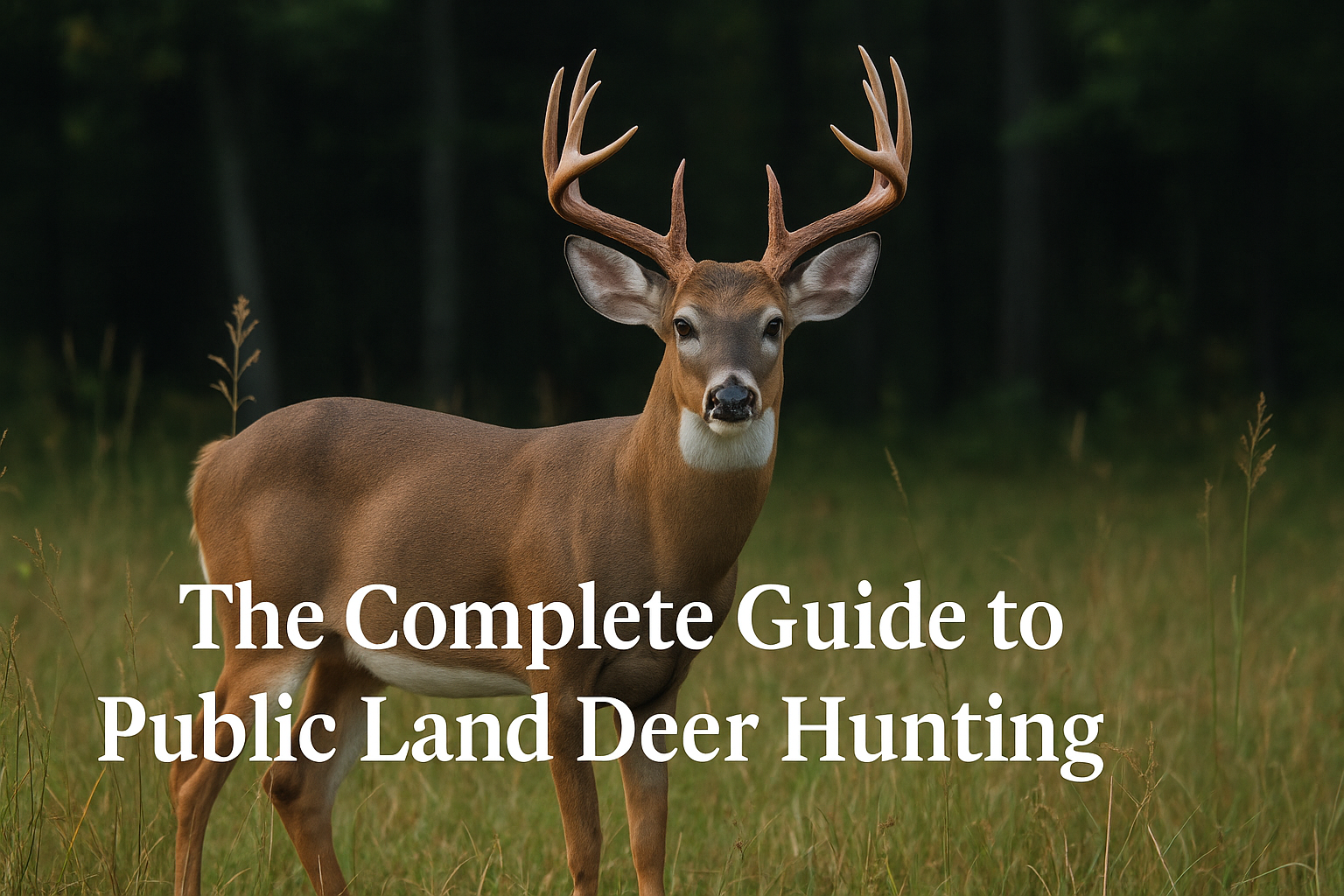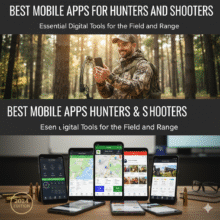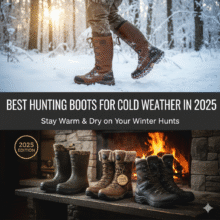The Complete Guide to Public Land Deer Hunting

Table of Contents
- Introduction
- Understanding Public Lands
- The Advantages and Challenges of Public Land Hunting
- Know the Rules and Respect Boundaries
- Scouting and E‑Scouting: Laying the Groundwork
- Locating Deer on Public Lands
- Food Sources
- Water Sources
- Cover and Bedding
- Strategies for Public Land Success
- Arrive Early, Go Deeper and Stay Longer
- Use Hunting Pressure to Your Advantage
- Hunt the Edges of Private Land
- Look for Small, Overlooked Parcels
- Play the Draw Odds
- Be Mobile: Still‑Hunting and Ground Seats
- Gear List for Public Land Deer Hunts
- Safety and Etiquette on Public Land
- Conclusion
Introduction
Public lands are one of the greatest assets available to hunters. In the United States alone, the federal government owns roughly 640 million acres – about 28 percent of the country’s landmass – while state and local governments hold another 199 million acres. These lands are managed by agencies like the Bureau of Land Management, U.S. Forest Service and state wildlife departments, and many of them provide opportunities for Public Land deer hunting. Because they are open to the public, they offer a chance to explore large tr
acts of habitat and pursue whitetails without the need for private leases. Hunting public land requires preparation, respect for regulations and fellow hunters, and a willingness to adapt to changing conditions. This comprehensive guide will help you navigate the complexities of hunting deer on public ground—from understanding how public lands are managed to scouting, strategy, equipment, safety and ethics. By the end, you’ll have
Understanding Public Lands
Public land is an umbrella term for property owned by federal, state or local governments. Each jurisdiction manages its lands differently. The Bureau of Land Management (BLM), U.S. Forest Service (USFS), U.S. Fish and Wildlife Service (FWS) and National Park Service (NPS) oversee most federal holdings, while state wildlife agencies manage state forests and wildlife management areas. The sheer scale of these lands means that there are countless places to hunt, but knowing the type of land and its governing body helps you understand which rules apply.
On federally owned property, hunting is usually permitted on National Forests and BLM land but may be restricted or prohibited in national parks and wildlife refuges. Many federal lands require only a valid state hunting license; however, some national wildlife refuges or military installations draw names through lottery systems.
State lands wildlife management areas, state forests and public hunting areas often have additional regulations such as permit requirements or limited seasons. County or municipal lands are sometimes open to hunting but may require special permits. Because each parcel can have unique rules, research the specific property you intend to hunt.
The Advantages and Challenges of Public Land Hunting
Public land offers a chance to explore large habitats and chase deer that are often more wary than their private land counterparts. You can move freely across thousands of acres, follow deer migrations and access remote backcountry. With no lease fees, public hunting is also more affordable.
However, there are challenges. Public land deer are exposed to more hunting pressure and human activity, which makes them cautious. You will likely encounter other hunters during the season; the National Survey of Fishing, Hunting and Wildlife‑Associated Recreation estimates that 14.4 million Americans are hunters. Competition for prime spots can be intense on opening day or during the rut. Success requires scouting, patience and the ability to adjust your tactics.
Know the Rules and Respect Boundaries
Before stepping onto public land, familiarize yourself with the regulations for that particular parcel. Not all public land is open to hunting. Season dates, bag limits, allowed weapons and special permits vary by state and sometimes by individual area. Most states require hunters to complete a hunter education course and carry the appropriate license and deer tags. In addition:
Confirm access: Some areas are closed during specific dates or only accessible through entry points. Others require special permits or check‑in stations. Many state agencies publish hunting guides or maps. Contact the local wildlife office if you have questions.
Understand boundaries: It is your responsibility to stay on public property. Hunters should know the boundaries and use maps or apps to ensure they don’t trespass. Public parcels often border private land, and animals may move between them. Hunting near these edges can be productive, but you must remain on public property unless you have permission for the private parcel.
Follow local bylaws and bylaws: Municipalities sometimes restrict discharge of firearms or require additional permissions. For example, Massachusetts’ deer‑hunting tips remind hunters to identify parking and access locations and check local town bylaws relative to hunting on private or municipal property.
Practice fair chase: Ethical hunting means pursuing game in a manner that does not give an unfair advantage. Avoid actions like baiting in areas where it is illegal, spotlighting deer at night or trespassing onto private land.
Scouting and E‑Scouting: Laying the Groundwork
Successful public land hunters invest significant time in scouting. Because deer on public lands encounter more people, they often shift their patterns and prefer secluded bedding and feeding areas. Scouting can be divided into two phases: e‑scouting using digital maps and boots‑on‑the‑ground scouting.
E‑scouting uses satellite imagery, aerial maps and topographic layers to identify potential hotspots before you ever set foot on the land. Modern mapping apps like onX Hunt or state‑provided mapping tools display land ownership boundaries and terrain features. The onX article notes that turning on the “government lands layer” helps hunters see public parcels and avoid trespassing.
Tools such as Google Earth or the MassWildlife Lands Viewer allow you to look for habitat edges, travel corridors and access points. Focus on areas where different habitat types meet—swamp edges, agricultural fields adjacent to forests, or logged areas next to mature woods. According to the Massachusetts Division of Fisheries and Wildlife, places with a mix of habitat types provide abundant food and cover. Deer thrive in these “edges” and will travel along them to move between bedding and feeding areas.
- Food sources: Agricultural fields, mast‑producing hardwood stands like white oaks, or clearcuts with browse. Deer favor acorns and beech nuts in the fall and agricultural fields such as soybeans, corn and clover are productive.
- Water sources: Deer drink multiple times per day. Large bucks need three to five quarts of water daily and may be attracted to even small puddles.
- Cover and bedding areas: Thick brush, briar patches or swamp islands provide security for deer. Public land deer often bed where they can escape pressure and watch for approaching hunters.
- Travel corridors: Saddles, ridges and stream crossings funnel deer movement. Use topographic maps to identify low‑lying saddles or narrow ridges that deer use as natural highways.
- Deer sign: Tracks, trails, rubs and scrapes reveal deer presence. Large tracks or multiple intersecting trails can indicate heavy use. Deer scat can show what deer are eating—green indicates vegetation, gray suggests acorns and nuts, and brown shows a diverse diet. Trail cameras along runs will help confirm patterns.
- Topographic pinch points: Funnels and narrow strips of cover between open areas or the heads of drainages concentrate deer movement and can be ideal stand sites.
Boots‑on‑the‑ground scouting should verify what you saw online and identify specific stand or ambush locations. Walk the property during late winter, early spring or immediately after the season ends. With foliage down, sign such as old rubs and scrapes are more visible.
Look for tracks and trails; deer often reuse the same trails, leaving well‑worn paths. Large tracks or multiple intersecting trails can indicate heavy use. Deer scat can reveal what deer are eating—green scat shows they are feeding on vegetation, gray indicates acorns and nuts, and brown shows a diverse diet. Setting trail cameras on these trails will help you confirm deer presence and patterns.
Locating Deer on Public Lands
Deer are creatures of habit, but their routines on public land are influenced by pressure. They need to eat, drink and rest, but they may do so at night or in more remote locations. Focus on the following factors:
Food Sources
Whitetails are opportunistic feeders. In the early season they may feed on green browse such as clover, alfalfa and young shoots. As autumn progresses, hard mast like acorns and beech nuts become critical. White oak acorns are highly preferred and often drop earlier, making them a good focus for early archery season. Red oak and other species drop later, providing food well into gun season.
When hunting near agricultural fields, avoid sitting directly on the field edge; instead, set up along the deer’s entry or exit trails off the field. In big woods, search for clearcuts or logging edges where new growth attracts deer.
Water Sources
Deer drink frequently. Even a small puddle can be a reliable water source if it is close to bedding areas. Public land often has ponds, creeks and wetlands. Deer will drink multiple times a day, and even a simple puddle may suffice. Identify water sources on maps and check them for tracks. Hunting near secluded water especially during warm early season can be very effective.
Cover and Bedding
On heavily hunted land, deer seek security cover that allows them to avoid human contact. Thick brush, swamps and steep ridges are typical bedding areas. Bedding often relates to wind and terrain; deer like to bed with the wind at their back and a clear view in front. Finding beds will help you plan access routes that keep the wind in your favor. Because public land deer respond quickly to pressure, bedding may change when hunters move in. Monitor bedding areas through the season and adjust accordingly.
Strategies for Public Land Success
Once you’ve scouted and identified promising locations, develop a hunting strategy that accounts for pressure and deer behavior. Here are several approaches:
Arrive Early, Go Deeper and Stay Longer
Set up earlier, hike farther and stay longer than other hunters. Arriving before daybreak allows you to slip quietly into your stand without spooking deer or bumping into other hunters. Many hunters won’t venture far from access roads; by hiking deeper into the property you can find less pressured deer. Staying until the end of legal shooting light also helps, as deer often wait until the last minutes of daylight to move.
Use Hunting Pressure to Your Advantage
Hunting pressure can push deer toward you. When other hunters enter an area, deer often slip to less pressured pockets or use alternate routes. Observe where others park and guess where they may hunt. Position yourself off those lines of travel so deer bumped by others come past you. Don’t abandon an area just because you see other hunters—adjust your plan to take advantage of the pressure.
Hunt the Edges of Private Land
Public parcels that border private fields or timber can be productive because deer often feed or seek refuge on private land then travel through public strips at dawn and dusk. Hunting public spots near private land increases success, especially when pressure pushes animals across boundaries. Always confirm boundaries and secure permission before crossing onto private land.
Look for Small, Overlooked Parcels
Many hunters focus on large, well‑known areas. Smaller parcels or those that appear inconvenient to access can provide great hunting because they receive less pressure. Use maps to find landlocked parcels accessible via easements, or tiny tracts near towns that others dismiss. These overlooked parcels often hold unpressured deer and can yield excellent opportunities.
Play the Draw Odds
Some public lands require special permits or are managed through lottery systems. Applying for these hunts can yield opportunities with limited competition. Research your state’s quota hunts, lottery hunts or controlled hunts and put your name in as many draws as your budget allows.
Be Mobile: Still‑Hunting and Ground Seats
Because public land deer can change patterns quickly, being mobile helps you adapt. Use lightweight climbing stands or saddle systems to set up quickly in fresh sign. When conditions are right—such as damp leaves or snow consider still‑hunting. This method of slowly and quietly stalking through the woods can be effective in big timber where deer seldom encounter still‑hunters.
Gear List for Public Land Deer Hunts
Your public land hunting gear should balance mobility with preparedness. Pack light but carry the essentials needed for navigation, safety and field processing.
Navigation tools: A GPS or phone mapping app with offline maps and a compass. Always carry a paper map as a backup.
Tree stand or saddle: Lightweight climbers, hang‑on stands or saddles allow you to adapt to fresh sign. Portable ground blinds can work in open areas.
Safety harness: Always wear a harness when hunting from an elevated stand to prevent falls.
Backpack: Choose a pack large enough to carry extra clothing, water, snacks, field‑dressing tools and emergency gear. A pack with an external frame can help transport meat.
Clothing and footwear: Dress in layers appropriate to the season. Waterproof boots and rain gear are essential. Wear blaze orange or other required safety colors where mandated.
Scent control and attractants: Use unscented soap and store clothing in scent‑free bags. Mock scrapes or scent drippers can be used if legal.
Field‑dressing kit: Pack a sharp knife, latex gloves, game bags, rope and a drag harness to help process and transport your deer.
Safety and Etiquette on Public Land
When you hunt public land, you share the woods with other hunters and non‑hunters. Staying safe and respectful is paramount:
Field Dressing, Transporting and Reporting Your Harvest
Taking a deer on public land is only half the challenge. Once you punch your tag, you need to recover, dress and transport the animal efficiently and ethically.
Field dressing removes the internal organs to cool the meat quickly and prevent spoilage. Wear gloves, use a sharp knife and follow your state’s recommended steps. If you are far from the road, consider quartering the animal and packing it out in manageable loads.
Transport your harvest discreetly. Cover the deer with a tarp if possible and secure it properly in your vehicle or on a game cart. Some states require you to display a tag on the carcass; others require online or phone check‑in. Always follow your public land unit’s specific tagging, sealing and reporting requirements to avoid fines or lost privileges.
Conclusion
Public land deer hunting is both a challenge and a privilege. Unlike private leases, public ground tests every skill a hunter has from map-reading and scouting to patience and perseverance. The freedom to roam thousands of acres comes with the responsibility to respect regulations, share the woods with others, and hunt ethically. Success often comes to those willing to walk a little farther, think a little harder, and adapt to ever-changing conditions. Whether you’re a seasoned hunter or stepping onto public land for the first time, remember that each trip offers not only the chance at a deer but also the opportunity to deepen your connection to wild places. Approach it with preparation, respect, and persistence and the rewards will follow.







